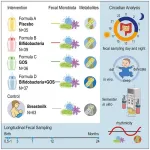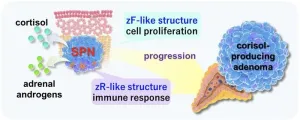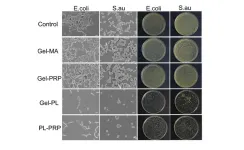(Press-News.org) Infant gut microbiomes oscillate with a circadian rhythm, even when they are cultivated outside of the body. Researchers report April 2 in the journal Cell Host & Microbe that the rhythm is detectable as early as 2 weeks after birth but becomes more pronounced with age. The finding comes from a randomized controlled trial that also showed that diet has less impact on the development and composition of the infant microbiome than previously thought.
“We found that even at very early ages of colonization, the microbial ecosystem develops this circadian rhythmicity,” says senior author and microbiome expert Dirk Haller of the Technical University of Munich. “We have shown these rhythms before in adults, but we were not sure when these mechanisms first appear.”
While diet had only a marginal impact on infant microbiome development, the researchers showed that age plays a more important role.
“Diet matters, but less than aging of the gut,” says Haller. “When we compared breastfed and formula-fed infants, the differences in microbiome colonization were marginal. Our intestinal system is probably a little bit more flexible in adapting to what the environment has to offer.”
The researchers used a randomized controlled trial to compare microbiome development in infants that were exclusively breastfed with infants who received different types of formula—un-supplemented formula; formula containing breast-milk-derived bacteria (Bifidobacteria); formula containing breast-milk-mimicking sugars (galacto-oligosaccharides, GOSs); or formula containing both Bifidobacteria and GOSs. Altogether, the trial included 210 infants.
To longitudinally track the infants’ microbiomes, the team sampled the infants’ stools when they were 0.5 months, 1 month, 3 months, 7 months, and 12 months of age as well as at 24 months for a subset of the infants. They also kept note of the time of day that the stool sample was collected.
The researchers found that diet had little impact on infant growth or the differences in the infants’ microbiomes. Though there was a lot of variation, all of the infants showed a gradual increase in gut microbe diversity, and at 24 months there was no observable difference between the groups. When they compared the different types of formula, they found that GOS-supplemented infant formula was more effective at promoting sustained levels of Bifidobacteria compared to formula containing Bifidobacteria.
However, there was a significant difference in the gut metabolite profile between exclusively breastfed and formula-fed infants. “The metabolite environment in the gut is dramatically different between a baby that is exclusively breastfed and babies that receive infant formula, which could have a fundamental impact on metabolic priming and many downstream effects,” says Haller. “We can conclude that breast milk does something completely different in the metabolism in in the infant’s intestine.”
The researchers also observed rhythmic 24-hour fluctuations in the abundance of different microbiome species. When they took infant microbes and grew them in continuous culture in the lab, the bacteria settled into the same circadian rhythm—even in the absence of external light or host cues. Though circadian rhythms have been previously observed in adult microbiomes, this is the first evidence that bacteria maintain these rhythms independently.
“When we take them out, they maintain these daytime-related diurnal oscillations,” Haller says. “This is fairly surprising because it suggests that the bacteria have some intrinsic mechanism that provides some sort of adaptation to a day and night cycle, which could potentially give them an advantage in colonizing the human intestine.”
The researchers plan to further investigate microbiome circadian rhythms in future studies. Specifically, they want to examine whether individual bacterial species maintain rhythms when grown in isolation rather than in complex communities and to search for the genes that control these rhythms.
“For us, the next question is can we identify mechanisms in bacteria that control their circadian behavior,” says Haller.
###
This research was supported by Töpfer GmbH, the German Research Foundation, the Joint Programming Initiative of the European Union, and the German Ministry of Education and Research.
Cell Host & Microbe, Heppner et al., “Diurnal rhythmicity of infant fecal microbiota and metabolites: A randomized controlled interventional trial with infant formula” https://cell.com/cell-host-microbe/fulltext/S1931-3128(24)00058-1
Cell Host & Microbe (@cellhostmicrobe), published by Cell Press, is a monthly journal that publishes novel findings and translational studies related to microbes (which include bacteria, fungi, parasites, and viruses). The unifying theme is the integrated study of microbes in conjunction and communication with each other, their host, and the cellular environment they inhabit. Visit http://www.cell.com/cell-host-microbe. To receive Cell Press media alerts, contact press@cell.com.
END
ROCHESTER, Minn. — A new multicenter, international study suggests that people who have early-stage triple-negative breast cancer (TNBC) and high levels of immune cells within their tumors may have a lower risk of recurrence and better survival rates even when not treated with chemotherapy. The study was published in the Journal of American Medical Association (JAMA).
TNBC is a breast cancer subtype that does not respond to drugs that target the estrogen receptor or the HER2 protein. It grows rapidly, is more likely to spread beyond the breast before diagnosis ...
Fukuoka, Japan—Researchers from Kyushu University's Faculty of Medical Sciences report on new insights into the mechanisms of how adrenal gland tumors are formed. The team identified a new type of tumor cell population that they termed 'steroids-producing nodules' or SPNs, that exhibits the unique characteristic of producing two different hormones. Specific structures in SPNs were found to lead to cortisol-producing adenomas, or CPAs, noncancerous tumors that produce excessive cortisol.
Their findings, published in eBioMedicine, ...
· AI responses to common patient questions were on par or exceeded answers from professional societies
· Goal also to reduce clinician workload and burnout
· More than 60% of cancer patients require radiation oncology treatment
CHICAGO --- Cancer patients about to undergo radiation oncology treatment have lots of questions. Could ChatGPT be the best way to get answers?
A new Northwestern Medicine study tested a specially designed ChatGPT to see if it could successfully provide answers to patients’ common questions about radiation oncology. Patients may be too overwhelmed to address all their concerns during a clinical visit ...
About The Study: In this study of 9,740 surveillance colonoscopies among 9,601 adults ages 70 to 85 with prior colorectal adenoma, colorectal cancer detection was rare regardless of prior adenoma finding, whereas the advanced neoplasia yield was 12% overall. Yields were higher among those with a prior advanced adenoma than among those with prior nonadvanced adenoma and did not increase significantly with age. These findings can help inform whether to continue surveillance colonoscopy in older adults.
Authors: Jeffrey K. Lee, M.D., M.P.H., of Kaiser Permanente Northern California in Oakland, is the corresponding author.
To access the embargoed study: ...
About The Study: High levels of glucose and triglycerides and low levels of high-density lipoprotein were associated with future risk of depression, anxiety, and stress-related disorders in this study of more than 200,000 participants. These findings may support closer follow-up of individuals with metabolic dysregulations for the prevention and diagnosis of psychiatric disorders.
Authors: Charilaos Chourpiliadis, M.D., of the Karolinska Institutet in Stockholm, is the corresponding ...
WASHINGTON, April 2, 2024 – Hydrogels are popular for use in skin ailments and tissue engineering. These polymer-based biocompatible materials are useful for their abilities to retain water, deliver drugs into wounds, and biodegrade. However, they are complicated to manufacture and not very resilient to external forces like rubbing against clothing, sheets, or wound dressings. They are also not inherently able to battle bacterial infections, so they are often infused with antimicrobial drugs or metal ions, which can ...
The human body uses adhesion to hold itself together. For example, a tendon attaches muscle to bone, while connective tissue attaches muscle to skin.
Hydrogel-based soft materials are based on these biomimetic mechanical behaviors, which makes them a revolutionary design of biomedical implants, human-machine interfaces, and bio-inspired soft robots. However, there are limitations to overcome before they are able to fully replace commonly used hard materials.
Qihan Liu, assistant professor of mechanical and materials ...
Changes in the gut microbiome have been implicated in a range of diseases including type 2 diabetes, obesity, and inflammatory bowel disease. Now, a team of researchers at the Broad Institute of MIT and Harvard along with Massachusetts General Hospital has found that microbes in the gut may affect cardiovascular disease as well. In a study published in Cell, the team has identified specific species of bacteria that consume cholesterol in the gut and may help lower cholesterol and heart disease risk in people.
Members of Ramnik Xavier’s lab, Broad’s Metabolomics Platform, and ...
Cells within the intestines perform various roles including nutrient absorption, sensing, and maintaining homeostasis. Certain chronic disorders are distinctly characterized by gut inflammation, which disrupts intestinal cells and can lead to a remodeling of the gut and the introduction of new immune cells. To better understand the types of cells and their positioning within the intestines, researchers at Brigham and Women’s Hospital, a founding member of the Mass General Brigham healthcare system, in collaboration with investigators ...
If you want to spread a message about climate change and global warming, you need to adapt the message according to your intended audience and what you want to achieve.
Researchers have now developed an app to help people who want to spread their message on climate issues to ensure they generate the most support possible – be they researchers, politicians, various decision makers or legislators.
Huge survey involving 63 countries
59,000 people participated in surveys as part of the work on creating the app, and Norway was among ...


